Opinion
Country of the young
For the first time in its history, Nepal is experiencing a demographic dividend. According to Nepal’s National Youth Policy, approximately 20.8 percent of total population of the country falls in the age group 16-25 years while 40.68 percent of the population lies in the age group 16-40. This phenomenon, where the youths account for the largest segment of the population of any country is defined as ‘population dividend’ or ‘youth bulge’. This provides a unique opportunity for Nepal. 
Brabim Kumar
For the first time in its history, Nepal is experiencing a demographic dividend. According to Nepal’s National Youth Policy, approximately 20.8 percent of total population of the country falls in the age group 16-25 years while 40.68 percent of the population lies in the age group 16-40. This phenomenon, where the youths account for the largest segment of the population of any country is defined as ‘population dividend’ or ‘youth bulge’. This provides a unique opportunity for Nepal.
Young and restless
Still, the youth bulge in any country can also become a challenge if the nation fails to understand its dynamics. Globally, dissatisfied youths have been the reason behind quite a few movements since 2010: the Arab Spring revolution in 2010; riots in London later in September of the same year; and the Occupy Wall Street movement in the US in 2011.
Many institutions, including the International Labour Organisation, that have studied this phenomenon have found that countries with a higher Not in Education, Employment or Training (NEET) ratio face greater risks. Such disengaged people are also called ‘discouraged youths’. Researches show that the population of NEET in Nepal is around 15 percent, which could be a lot more as more than 80 percent of the youth is employed in the non-formal sector.
Nonetheless, Nepali youths have made significant contributions to all political movements and continue to make economic contributions. In the last fiscal year, Nepali youths sent about $770 million USD as remittances. There are about three million Nepali youths currently working in the Gulf and other countries. About 55 percent of Nepali households have at least one family member outside the country. Thus, the remittance directly benefits their households and the community. On the flip side, only one percent of the youths who go abroad for work are either skilled or trained—about 24 percent of youths who leave the country are semi-skilled and the majority of them, 75 percent, are unskilled.
On the political front, Nepal has always witnessed exceptional levels of enthusiasm of its youth during and in the aftermath of various movements. Yet, once the struggle comes to an end, they seldom get leadership roles.
Reaping the benefits
Nepal immensely benefited from its youth bulge in the aftermath of the Great earthquake too. Youths sprung into action, determined to play an important role in the rescue and relief operations. Over 50,000 youth volunteers were mobilised in the Capital alone and many more were engaged in a wide range of activities—cleaning up roads, setting up toilets at temporary shelters, distributing medical supplies—through district level clubs and youth groups.
Nepali youths proved their ability and dedication to lead and mobilise themselves during the disaster. Hundreds of informal youth groups immediately responded by helping communities in rescue and relief work. The youth were able to help communities in time, and more importantly, help areas where the state had failed to reach.
Even previously inactive youth groups organised themselves and rescued people in various parts of Kathmandu—they volunteered at hospitals crowded with injured people. Local youth clubs coordinated themselves and cleaned the streets of Kathmandu to prevent an epidemic. Informal youth groups deployed teams to provide emergency relief (basic supplies and service) to the affected areas to
the best of their ability by making use of funds raised through their personal and professional networks. Young people continued to help those in need in spite of the damaged roads.
They continue to play a critical role in protecting, rehabilitating, and rebuilding the lives of many quake-affected people. In particular, some Nepali and foreign students reaching out to the affected communities with relief materials inspired others to do the same.
Give them a chance
As the aftershocks of the quake have now subsided, the tremendous impact of the volunteerism of the Nepali youths can now be observed across the country. The youths’ community participation and their endless energy has been vital. But the strong sense of national unity born from the collective sentiment that the country had undergone a shared traumatic experience, has been a core reason for the massive success of the youth’s relief efforts.
Through the youth led relief efforts, young people of Nepal have demonstrated that they are ready, willing and able to rebuild Nepal. Indeed, they have only just begun. In a country where children are loved and adults are respected, the motivated youth (albeit ignored) are making a strong statement and are rebuilding Nepal.
The Ministry of Youth and Sports is currently in the process of finalising ‘Youth Vision 2025’ and is revising the National Youth Policy of 2010. The role of the youth during all political movements and recent crises should be acknowledged by the state, donor communities, civil societies and political parties. Proper leadership roles should be given to the youth, and opportunities should be provided for youth-led organisations. The upcoming plans and policies should reflect the aspirations of youth.
Kumar is President of a national-level umbrella youth network




 5.27°C Kathmandu
5.27°C Kathmandu












